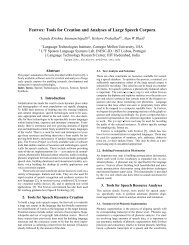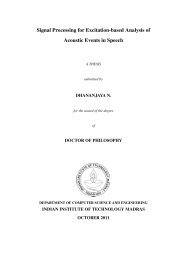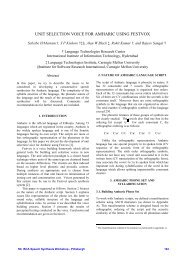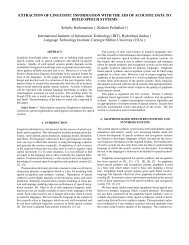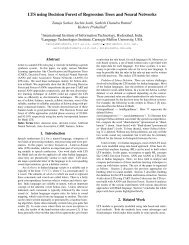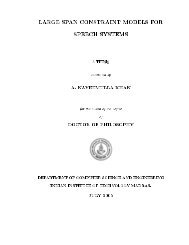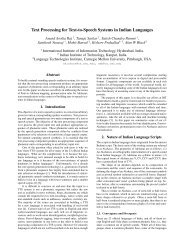word boundary- hypothesisation in hindi speech - Speech and ...
word boundary- hypothesisation in hindi speech - Speech and ...
word boundary- hypothesisation in hindi speech - Speech and ...
You also want an ePaper? Increase the reach of your titles
YUMPU automatically turns print PDFs into web optimized ePapers that Google loves.
<strong>speech</strong> signal-to-symbol conversion <strong>in</strong> the VOIS <strong>speech</strong>-to-text conversion system<br />
[Eswar 19901.<br />
From the cost matrix the cost nf substitlition for phonemes was estimated <strong>in</strong> the<br />
follow<strong>in</strong>g fzshioc: Let p be the observed phcriemc <strong>and</strong> q be the lnatch<strong>in</strong>g i;honeme.<br />
Then the cost of substitut<strong>in</strong>g p by q dur<strong>in</strong>g the lexical analysis was given by<br />
C(p,q) = 0, if P =q;<br />
C(p,q) = 1, if the row for p <strong>in</strong> the cost matrix conta<strong>in</strong>s q with a 'low' cost;<br />
C(p,q) = 2, if the cost matrix conta<strong>in</strong>s 'mid';<br />
C(p,q) = 4, if the cost matrix conta<strong>in</strong>s 'high';<br />
C(p,q) is <strong>in</strong>f<strong>in</strong>ite; if there is no entry for q <strong>in</strong> the row for p.<br />
In Fig.3.2, a small sentence segment, 'mcm na-m m-m was matched aga<strong>in</strong>st the<br />
lexicon <strong>and</strong> the various stages <strong>in</strong> match<strong>in</strong>g are shown. As seen from the figure, <strong>in</strong>itially<br />
two <strong>word</strong>s me: <strong>and</strong> me:rc were hypothesised as match<strong>in</strong>g the <strong>in</strong>itial portior? of the<br />
<strong>in</strong>put with zero cost <strong>and</strong> m l, me-la. <strong>and</strong> mai with a cost of one. From these, the lowest<br />
cost alternative me:ra- was selected for further match<strong>in</strong>g, produc<strong>in</strong>g the <strong>word</strong> str<strong>in</strong>gs<br />
mra- M=, me.-ra- mzm with zero cost <strong>and</strong> me:ra.- na, rne:ru- nam, me:ra-.narnr <strong>and</strong><br />
me.m mu- with a cost of one. These <strong>word</strong> str<strong>in</strong>gs were then stored back <strong>in</strong> the memory<br />
<strong>and</strong> match process was repeated. The figure shows all partial <strong>word</strong> sequences produced<br />
by the match whose costs were less than or equal to 1. It can be seen that many of the<br />
partial <strong>word</strong> sequences (for example, the <strong>word</strong> str<strong>in</strong>g me= nu-) were elim<strong>in</strong>ated due<br />
to the threshold on the maximum cost (one substitution). Complete <strong>word</strong> str<strong>in</strong>gs<br />
I<br />
match<strong>in</strong>g with cost less than or equal to the maximum cost are shown highlighted <strong>in</strong> the<br />
figure along with their cost.<br />
33 Lexical analysis without <strong>word</strong> boundaries<br />
The first study on the lexical analyser is to estimate its performance when the<br />
<strong>in</strong>put phoneme str<strong>in</strong>g conta<strong>in</strong>ed no <strong>word</strong> boundaries. Two parameters were used to





